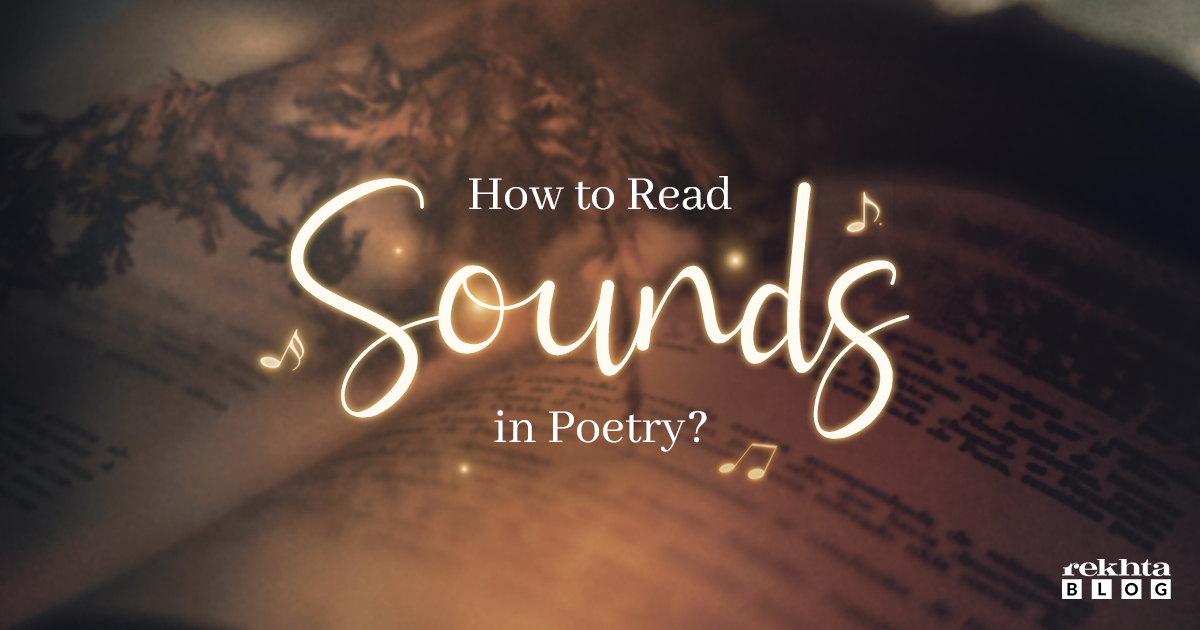
How to Read Sounds in Poetry?
Think, what first comes to your mind as you read a couplet?
Its idea, image, eloquence, assonance, or something else?
Barely are we drawn towards the sounds that envelope the syllables that we’re uttering.
Better, change uttering to reciting; reciting a verse with its metrical impulse is what transports a reciter and the audiences into a state of rapture.
Sounds, too, markedly add to a couplet’s meaning, and growing an ear for them can greatly enrich our experience of reading and understanding Ghazal.
Cutting short the Gyan, here are some select couplets wherein listening close to the sounds is what lifts the couplet to the tenor!
Let’s get started.
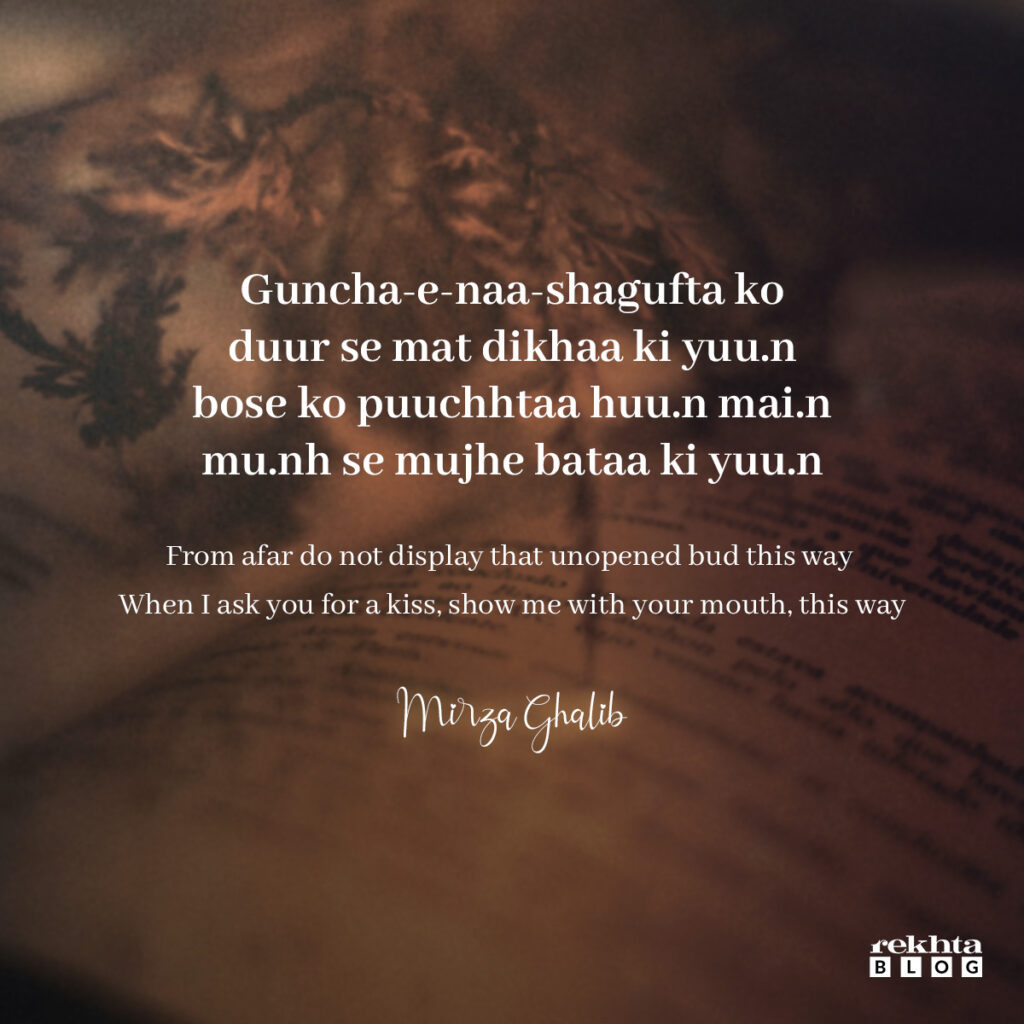
Hmm… the lover asking the beloved for a kiss; a real one and not its mere facsimile – the unbloomed bud – is nothing new. But note how the word-sounds are arranged in the meter – (Dum-Da-Da-Dum // Da-Dum-Da-Dum) X2 – makes for the perfect little peck!
The sounds are predominantly Uu-aa, Uu-aa, {Gun-cha/shaguf-ta/duu-r/ki-yuu.n} {Bo-se puuchh-taa/huu.n/mun.h/mu-jhe/ki-yuu.n}, guess what the sounds are all about?
The wretched Bosa, or kiss, tell me if this isn’t what a lip-lock is all about? Ummah!
Let’s move on to one of Urdu’s truly celebrated verses.
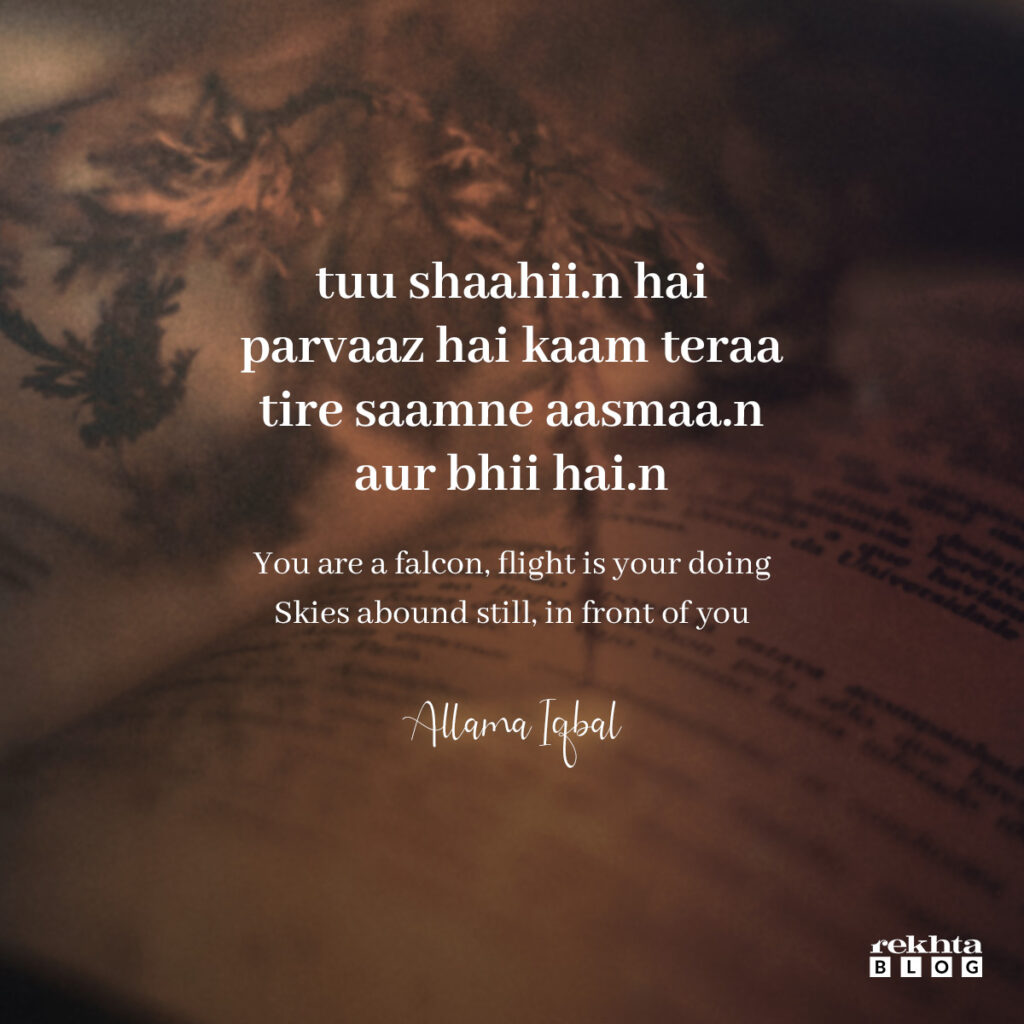
Iqbal is such a master of sounds that it was a challenge to pick one out of so many such verses.
Take in the meter, recite it, and hear out the loud, open sounds with the beat dropping on the bold parts – SHAhee.n, ParWAAZ, KAAm, TeRAA; SAAmne, Aasmaa.n, Aur.
Now, read aloud and notice the sounds bring alive the cadence, like the wing beats of a Royal Falcon – Tuu Shaahee.n (Wing Close), Hai Parwaa (Open), z Hai Kaa (Close), m Teraa (Open) – soaring high with a calm elegance above all skies that we can imagine. For some reason this verse reminds me of Articuno from Pokemon; yes, there is a not-that-nerd side to me as well.
Now, from one great poet to another, let’s rope in Mir:
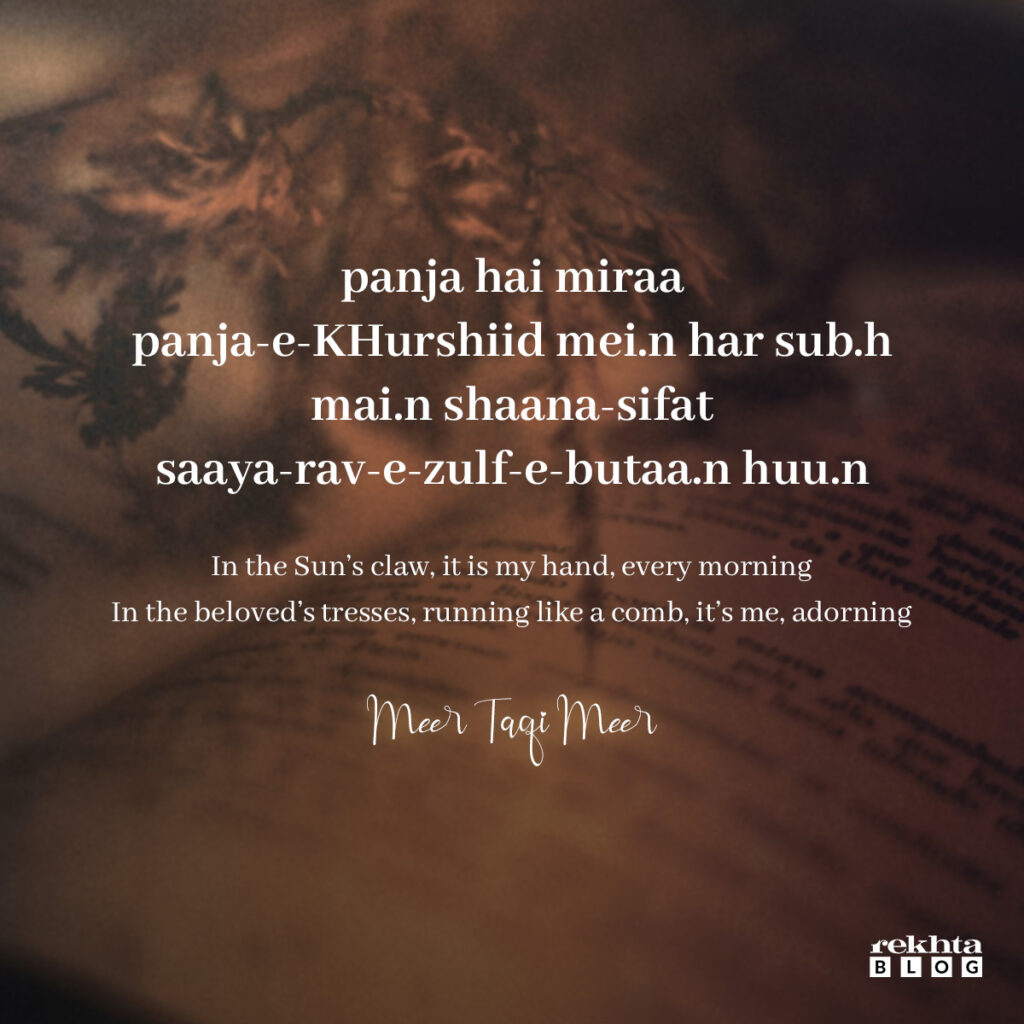
Among my personal favorites, this meter has such rich flowingness, and this entire Ghazal by Mir is a masterpiece.
So, what’s the verse about?
It’s morning, the beloved is facing the mirror, and a Mashshaata (hair-dresser) is to makeup her hair. But the lover has got such a thing for beauty that he, like the claw-resembling rays of the sun, sits himself carefully beneath her shadowy-ebony tresses, and then it is his hand that runs fluidly like a comb through her hair, every morning!
The contrasting long-short vowel sounds are so placed to give an effect of a comb moving back and forth. Now stretching and then drawing back, the sounds precisely mirror the scene – the lover lurking and creepingly combing the endless, dead-black, sinuous hair of the idol.
If a comb could speak, this is what it’d say!
Moving on, how about a couple of Persian couplets? Here’s Ghani Kashmiri:
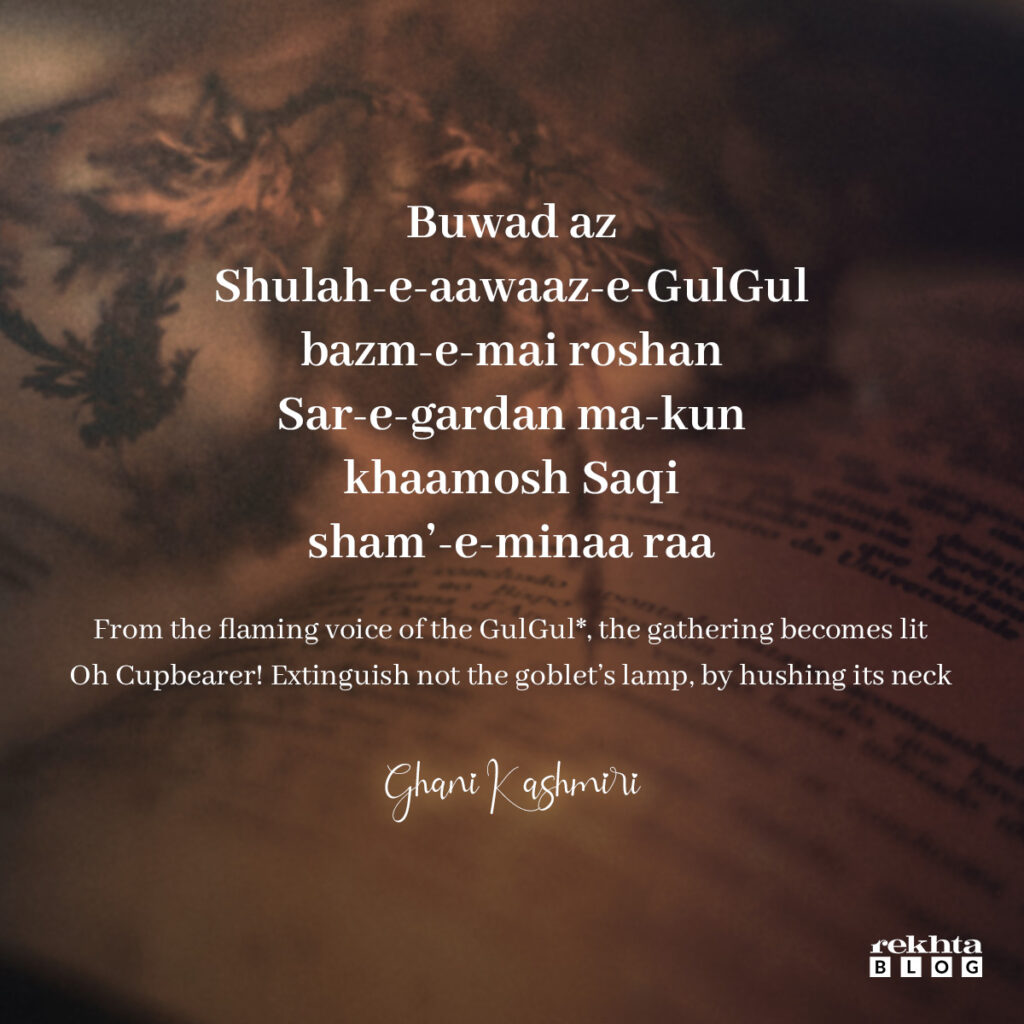
*GulGul- the noise made by liquor poured out from a narrow-necked vessel
It’s an intranslable verse really, and an exemplar of Sabk-e-Hindi poetics. The wordplay is so lit, that except buwad and ma-kun, each word has an affinity with at least one other word. But since here we’re focusing on soundplay, we’ll set aside the wordplay for some other fine day.
This is how the verse goes about in its meter:
bu-wad-az-Shu / la-e-aa-waa / ze-Ghul-Ghul-baz / me-mai-rau-shan
Sa-re-gar-dan / ma-kun-KHa-mo / sh-saa-qii-Sham / me-mii-naa-raa
Notice, as each Rukn, or foot (marked above by the oblique sign), shifts to the next one, a little pause pops up, right?
This break-like effect resonates in the words Shulah, aawaaz, bazm, Khaamosh, and Sham’a.
The reciter is forced to read these words in the verse like this: Shu-(pause)-lah, aawaa-(pause)-z, baz-(pause)-m, Khaamo-(pause)-sh, and Sham-(pause)-’a.
Wonder why this halt-in-sounds is introduced?
So that it can replicate the sound of wine pouring out of a Miina, which has a natural parenthesis to it.
It’s an amazing verse, and keeps getting better every time you recite it. Just hope the Saaqi doesn’t cease the rounds of wine.
Onwards, to the last couplet in our blog. Here’s another masterful Sabk-e-Hindi poet, Saaib Tabrezi, with verse in which its sounds overwhelm its imagery.
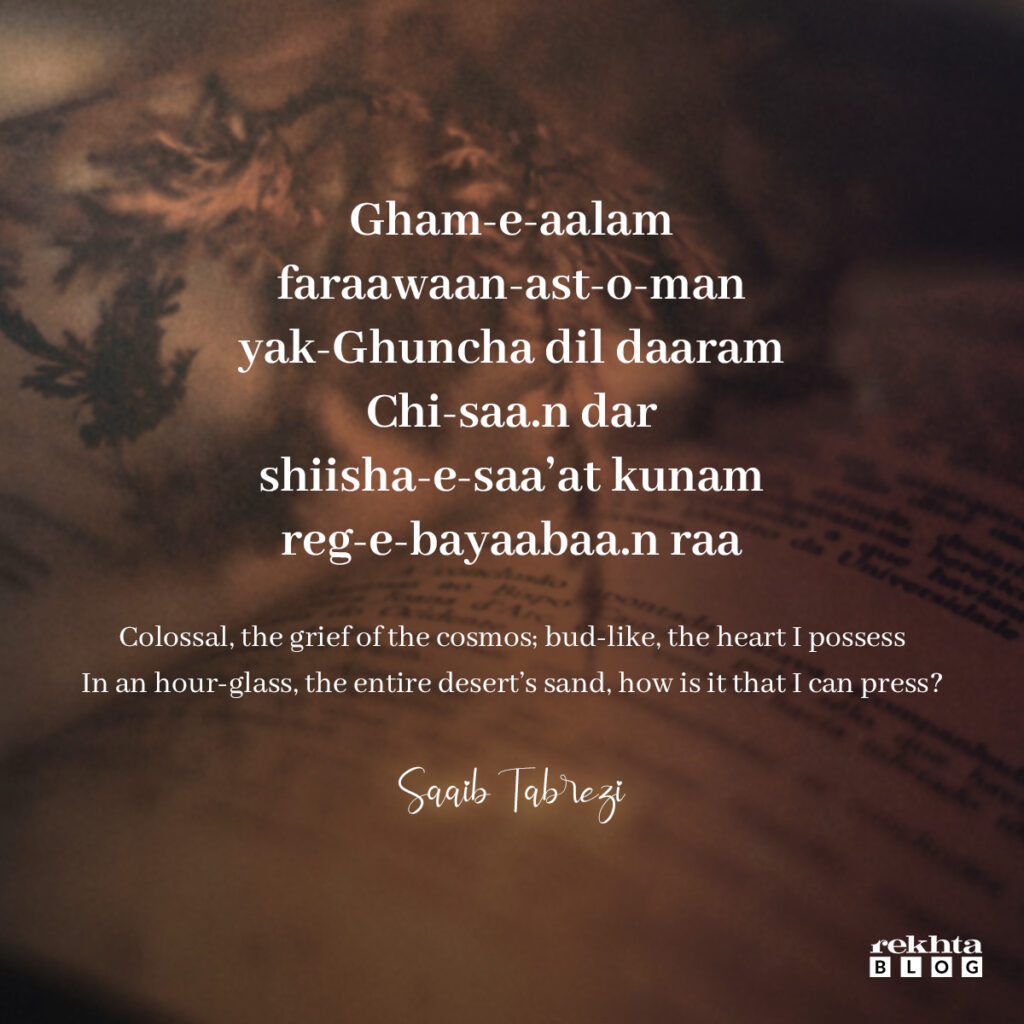
I’ll cut to the chase straightaway.
Aa-lam, f-raa-waa.n, Saaib uses loud, echoing ‘aa’ sounds to sonorously depict how “laaaaarge” the despair caused by existence is.
And instantly, in the other part of the line, the sounds contract: as-to, man, yak, Ghuncha, dil, you can practically recite the words with the narrowest aperture possible; again, all these commuted sounds resemble the smallness of the bud that the speaker’s heart is.
The second line clones the same effects by bringing in large-vowel sounds at the end to depict the expanse of the desert in ba-yaa-baa.n raa.
The couplet sounds like a Mantra beating in the heart of the universe, chanting Buddha’s ‘Sarvam Dukham’, It is all Grief.
We’ve reached the end and I truly hope this blog was able to give you an insight in the rich world of sounds and how reciting, and not merely reading, can help you appreciate great poetry with all its finest of aspects.
NEWSLETTER
Enter your email address to follow this blog and receive notification of new posts.




